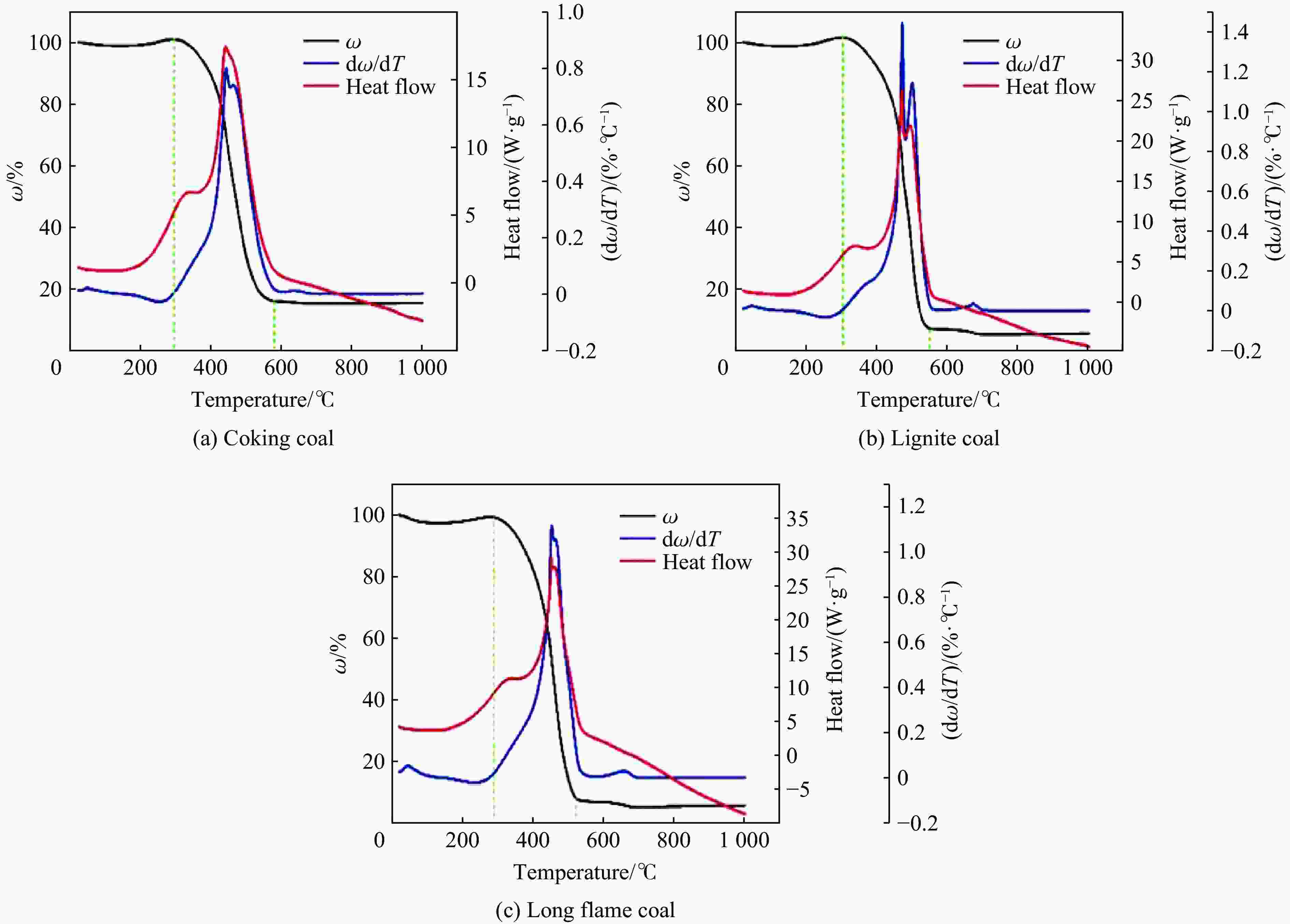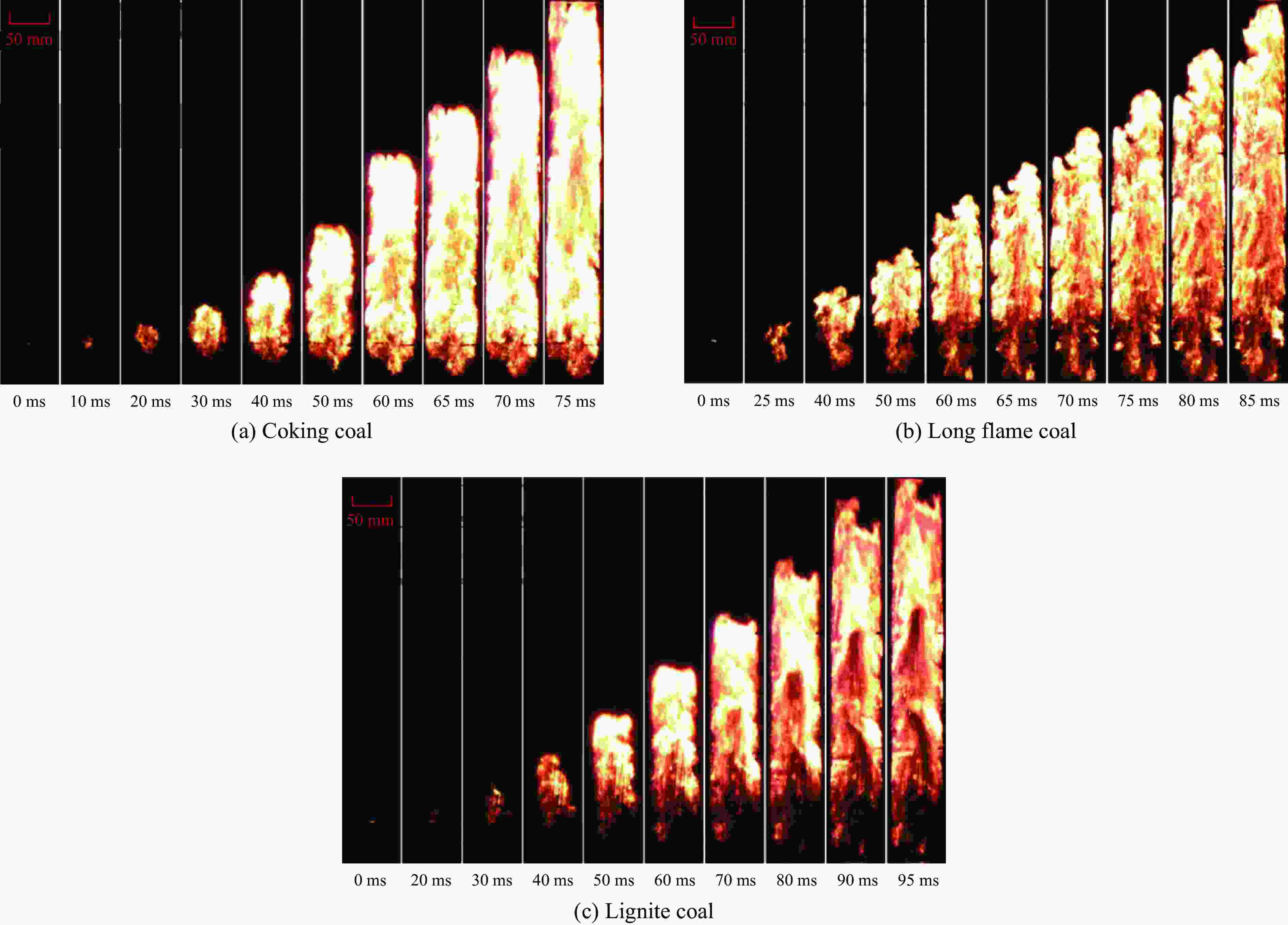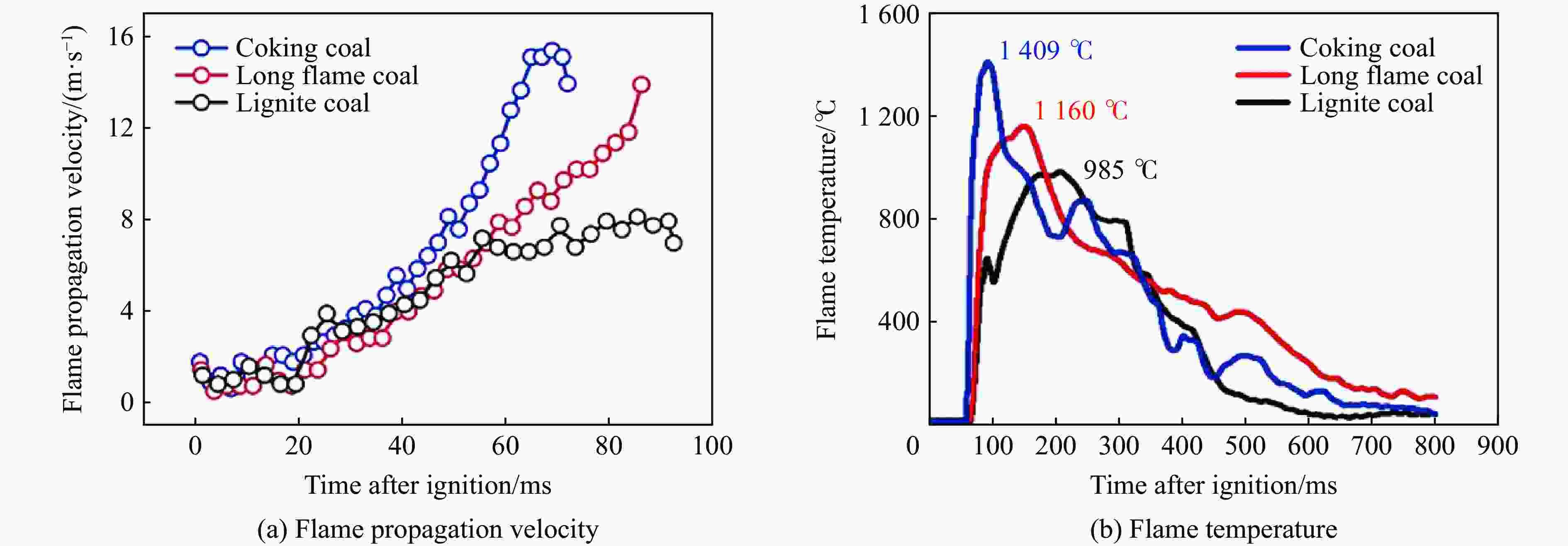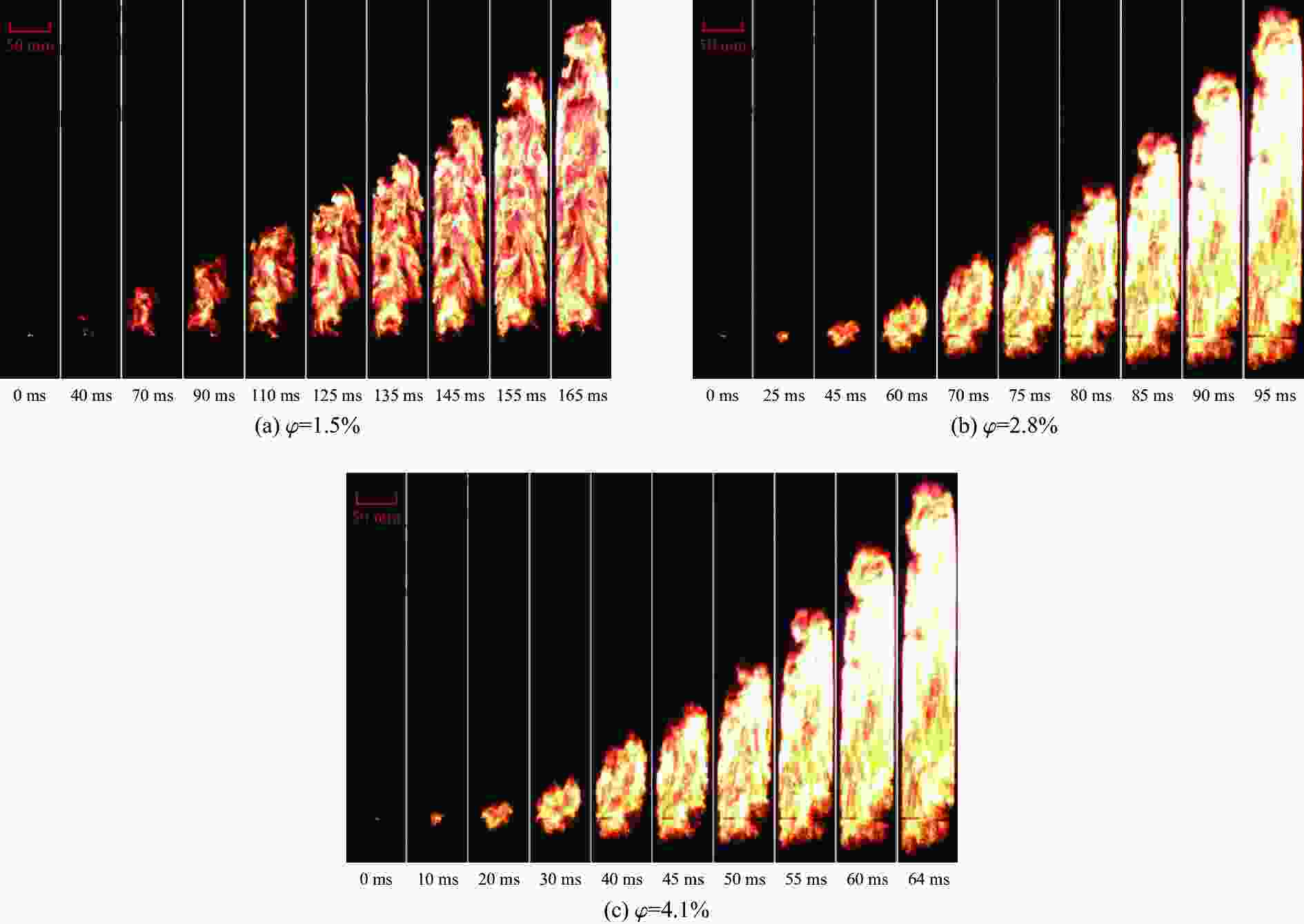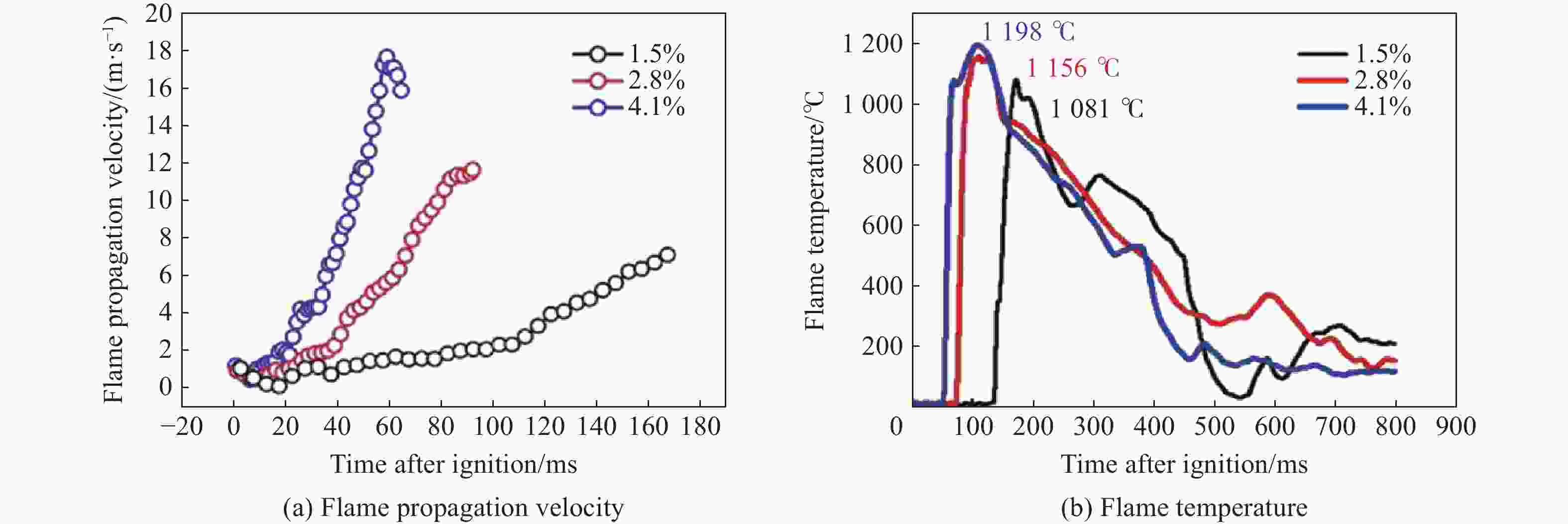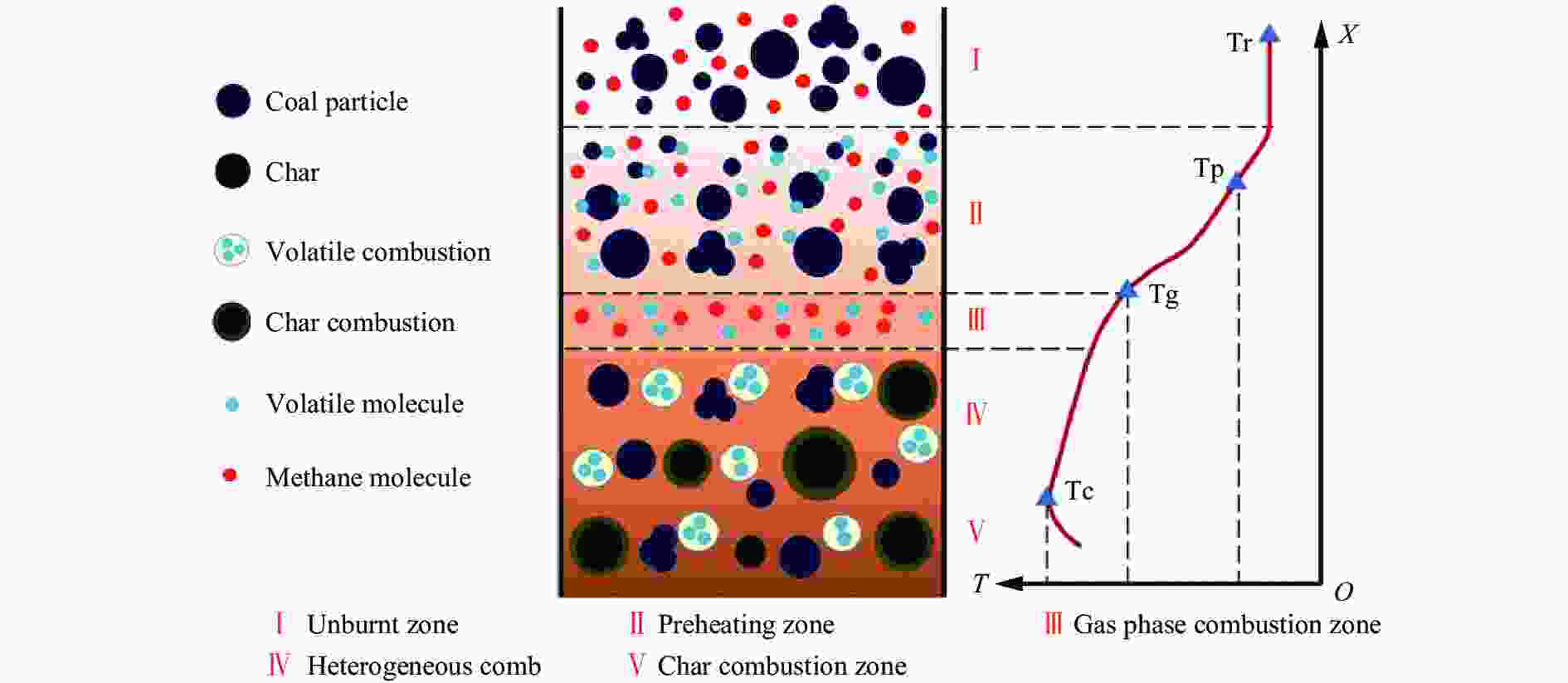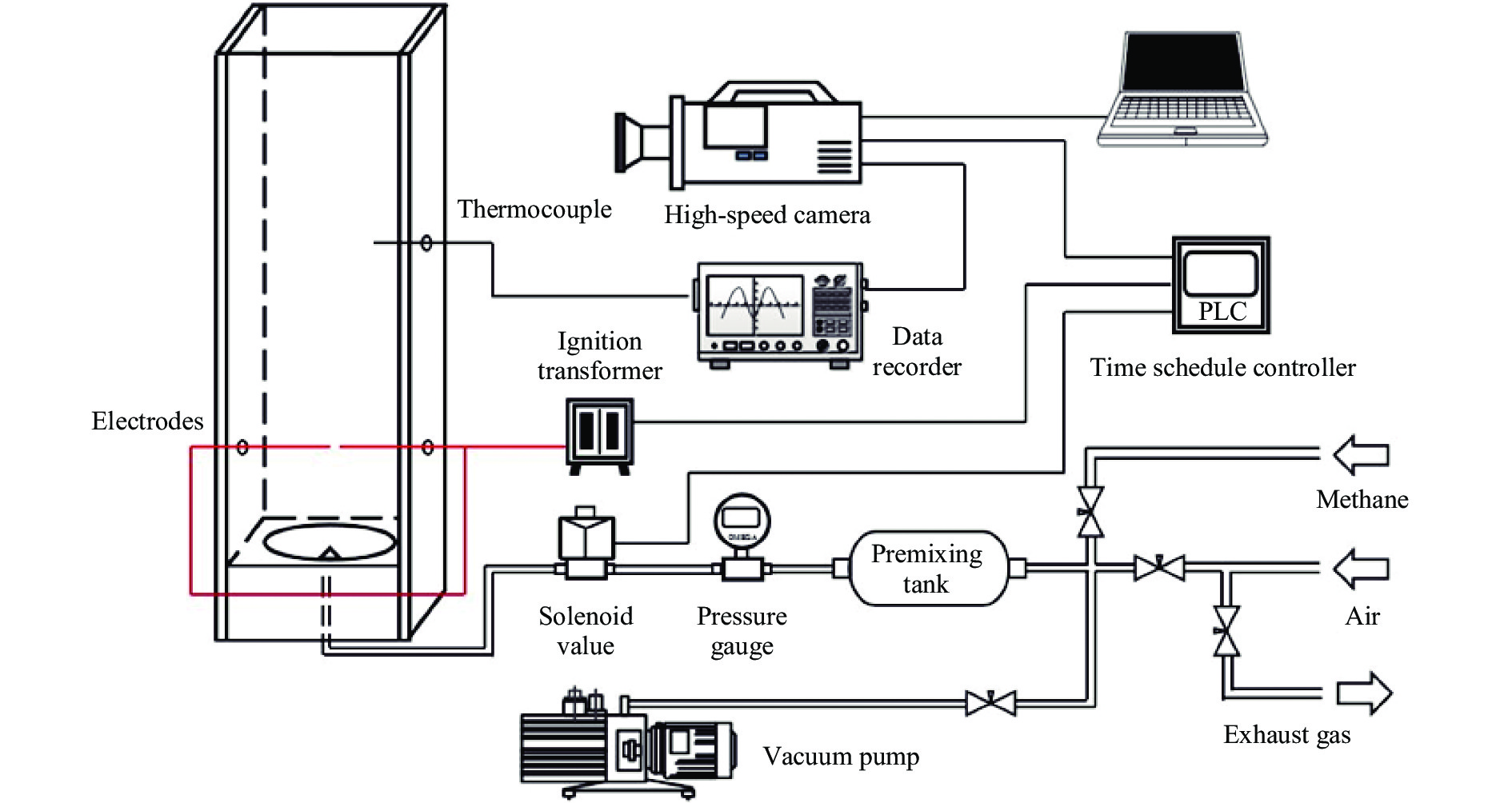Investigations on the flame propagation characteristics in methane and coal dust hybrid explosions
-
摘要: 为揭示甲烷/煤尘复合爆炸火焰的传播机理,利用气粉两相混合爆炸实验系统,在低于甲烷爆炸下限条件下,采用高速摄影机记录火焰传播图像,通过热电偶采集火焰温度,研究了煤尘种类以及甲烷体积分数对甲烷/煤尘复合火焰传播特性的影响。结果表明:挥发分是衡量煤尘燃烧特性的主导因素;随着煤尘挥发分的升高,燃烧反应增强,火焰传播速度升高,火焰温度升高;挥发分含量差异较小时,水分含量越低,燃烧反应越剧烈;在相同条件下,焦煤的燃烧反应强度最高,其次为长焰煤,最后为褐煤;随着甲烷体积分数的增加,煤尘颗粒的燃烧可由释放挥发分的扩散燃烧转变为气相预混燃烧,燃烧反应增强,火焰传播速度和火焰温度显著升高;热辐射和热对流作用促进煤尘颗粒热解,释放挥发分进行燃烧反应,维持复合火焰的持续传播;随着混合体系中甲烷体积分数的增加,混合爆炸机制由粉尘驱动型爆炸转为气体驱动型爆炸,燃烧反应增强;甲烷/煤尘复合爆炸火焰可由未燃区、预热区、气相燃烧区、多相燃烧区和焦炭燃烧区5部分组成,湍流扰动导致燃烧介质空间分布存在差异,使得燃烧区无规则交错分布。Abstract: To reveal the flame propagation mechanisms in the methane/coal dust hybrid explosions, the effects of coal type and methane concentration on the propagation characteristics of methane/coal dust hybrid explosion flame were experimentally investigated. Experiments were performed in a gas-solid hybrid explosion apparatus with methane concentrations below the lower explosive limit. The flame propagation images were captured by a high-speed camera and the flame temperature was recorded by a high-accuracy thermocouple. The results show that the volatile component is the dominant parameter in measuring the combustion characteristics of a certain coal type. With the increase of the volatile component, the combustion of the methane/coal dust flame gets enhanced. As a result, the flame propagation velocity increases and the flame temperature goes up. When the difference of the volatile component is small, due to the heat loss of the water evaporation, the combustion reaction of coal dust with lower water component is severer, the flame propagates more quickly. With the increase of the methane concentration, the combustion of the coal dust particle gradually transforms from the diffusion combustion of the released volatile components to the premixed combustion. The heat radiation and convection promotes the pyrolysis of the coal particle and the combustible substances are released, which maintains the continuous propagation of the hybrid flame. With the increase of the methane concentration, the hybrid explosion mechanism is transformed from the dust-driven type to the gas-driven type, and the combustion reaction gets enhanced. The methane/coal dust hybrid flame could be composed by five zones: unburned zone, preheated zone, gas combustion zone, multi-phase combustion zone and char combustion zone. Behind the flame front, large or the agglomerated particles could continue the combustion reaction, which is the multi-phase combustion zone. In addition, the combustion of the char develops the char combustion zone. The turbulent disturbance results in the distribution difference of the combustion materials, which leads to the interlacement of the different combustion zones.
-
表 1 煤样工业分析和元素分析结果
Table 1. Proximate and ultimate analysis of different coal species
煤尘种类 各组分质量分数/% 各元素质量分数/% 挥发分 水分 灰分 固定碳 C H O N S 焦煤 34.04 1.55 11.75 52.66 66.97 4.12 14.04 1.29 0.29 长焰煤 32.22 9.32 9.74 48.72 65.81 4.79 8.93 0.92 0.49 褐煤 26.50 5.14 6.78 61.59 71.73 4.00 10.39 0.73 1.24 表 2 煤尘粒径特性
Table 2. Characteristic parameters of the coal samples
煤尘种类 粒径/μm D[4,3]/μm D[3,2]/μm S/(m2·g–1) d(0.1)/μm d(0.5)/μm d(0.9)/μm 焦煤 0~75 22.745 6.138 0.978 2.604 16.665 51.655 褐煤 0~75 22.482 5.567 1.080 2.318 14.652 54.871 长焰煤 0~75 33.946 11.899 0.504 6.016 28.208 70.885 -
[1] YAN X Q, YU J L. Dust explosion incidents in China [J]. Process Safety Progress, 2012, 31(2): 187–189. DOI: 10.1002/prs.11482. [2] ZHENG Y P, FENG C G, JING G X, et al. A statistical analysis of coal mine accidents caused by coal dust explosions in China [J]. Journal of Loss Prevention in the Process Industries, 2009, 22(4): 528–532. DOI: 10.1016/j.jlp.2009.02.010. [3] MEDINA C H, MACCOITIR B, SATTAR H, et al. Comparison of the explosion characteristics and flame speeds of pulverised coals and biomass in the ISO standard 1 m3 dust explosion equipment [J]. Fuel, 2015, 151: 91–101. DOI: 10.1016/j.fuel.2015.01.009. [4] SERAFIN J, BEBCAK A, BERNATIK A, et al. The influence of air flow on maximum explosion characteristics of dust-air mixtures [J]. Journal of Loss Prevention in the Process Industries, 2013, 26(1): 209–214. DOI: 10.1016/j.jlp.2012.11.002. [5] MITTAL M. Limiting oxygen concentration for coal dusts for explosion hazard analysis and safety [J]. Journal of Loss Prevention in the Process Industries, 2013, 26(6): 1106–1112. DOI: 10.1016/j.jlp.2013.04.012. [6] LI Q Z, WANG K, ZHENG Y N, et al. Experimental research of particle size and size dispersity on the explosibility characteristics of coal dust [J]. Powder Technology, 2016, 292: 290–297. DOI: 10.1016/j.powtec.2016.01.035. [7] TURKEVICH L A, DASTIDAR A G, HACHMEISTER Z, et al. Potential explosion hazard of carbonaceous nanoparticles: explosion parameters of selected materials [J]. Journal of Hazardous Materials, 2015, 295: 97–103. DOI: 10.1016/j.jhazmat.2015.03.069. [8] CAO W G, QIN Q F, CAO W, et al. Experimental and numerical studies on the explosion severities of coal dust/air mixtures in a 20-L spherical vessel [J]. Powder Technology, 2017, 310: 17–23. DOI: 10.1016/j.powtec.2017.01.019. [9] AJRASH M J, ZANGANEH J, MOGHTADERI B. The effects of coal dust concentrations and particle sizes on the minimum auto-ignition temperature of a coal dust cloud [J]. Fire and Materials, 2017: e2437. DOI: 10.1002/fam.2437. [10] MISHRA D P, AZAM S. Experimental investigation on effects of particle size, dust concentration and dust-dispersion-air pressure on minimum ignition temperature and combustion process of coal dust clouds in a G-G furnace [J]. Fuel, 2018, 227: 424–433. DOI: 10.1016/j.fuel.2018.04.122. [11] BAYLESS D J, SCHROEDER A R, JOHNSON D C, et al. The effects of natural gas cofiring on the ignition delay of pulverized coal and coke particles [J]. Combustion Science and Technology, 1994, 98: 185–198. DOI: 10.1080/00102209408935404. [12] GAO W, DOBASHI R, MOGI T, et al. Effects of particle characteristics on flame propagation behavior during organic dust explosions in a half-closed chamber [J]. Journal of Loss Prevention in the Process Industries, 2012, 25(6): 993–999. DOI: 10.1016/j.jlp.2012.05.015. [13] JU W J, DOBASHI R, HIRANO T. Reaction zone structures and propagation mechanisms of flames in stearic acid particle clouds [J]. Journal of Loss Prevention in the Process Industries, 1998, 11(6): 423–430. DOI: 10.1016/S0950-4230(98)00027-8. [14] LI Q Z, LIN B Q, WANG K, et al. Surface properties of pulverized coal and its effects on coal mine methane adsorption behaviors under ambient conditions [J]. Powder Technology, 2015, 270: 278–286. DOI: 10.1016/j.powtec.2014.10.020. [15] AJRASH M J, ZANGANEH J, MOGHTADERI B. Methane-coal dust hybrid fuel explosion properties in a large scale cylindrical explosion chamber [J]. Journal of Loss Prevention in the Process Industries, 2016, 40: 317–328. DOI: 10.1016/j.jlp.2016.01.009. [16] 冯永安. 基于 20 L 球形爆炸装置的甲烷对煤尘爆炸影响实验研究 [D]. 太原: 中北大学, 2013.FENG Y A. Experimental study of methane effects on coal dust explosion in 20 L spherical hermetic device [D]. Taiyuan: North University of China, 2013. [17] DUFAUD O, PERRIN L, TRAORE M, et al. Explosions of vapour/dust hybrid mixtures: a particular class [J]. Powder Technology, 2009, 190: 269–273. DOI: 10.1016/j.powtec.2008.04.046. [18] 平洋. 煤粉瓦斯耦合体系着火机理和实验研究 [D]. 沈阳: 东北大学, 2011.PING Y. Ignition mechanism and experimental research on coal & gas coupling system [D]. Shenyang: Northeastern University, 2011. [19] ZHOU Y H, BI M S, QI F. Experimental research into effects of obstacle on methane-coal dust hybrid explosion [J]. Journal of Loss Prevention in the Process Industries, 2012, 25(1): 127–130. DOI: 10.1016/j.jlp.2011.07.003. [20] CLONEY C T, RIPLEY R C, PEGG M J, et al. Evaluating regime diagrams for closed volume hybrid explosions [J]. Journal of Loss Prevention in the Process Industries, 2017, 49: 912–918. DOI: 10.1016/j.jlp.2017.03.004. -







 下载:
下载:

